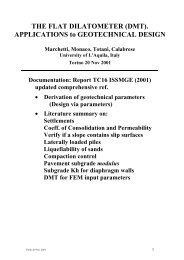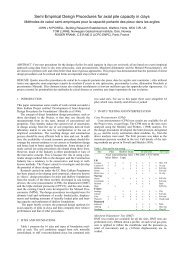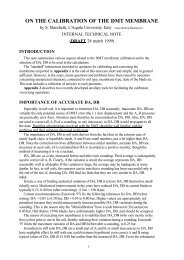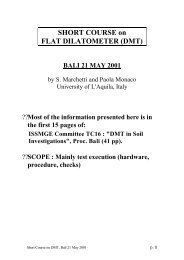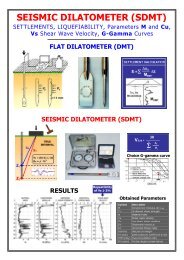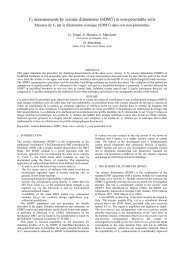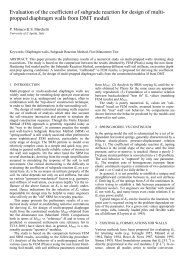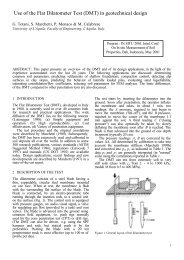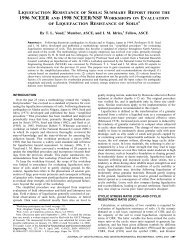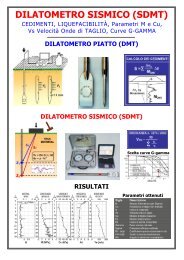The Flat Dilatometer Test (DMT) in Soil Investigations - Marchetti DMT
The Flat Dilatometer Test (DMT) in Soil Investigations - Marchetti DMT
The Flat Dilatometer Test (DMT) in Soil Investigations - Marchetti DMT
Create successful ePaper yourself
Turn your PDF publications into a flip-book with our unique Google optimized e-Paper software.
Fig. 15. Electrical contact po<strong>in</strong>ts to be kept clean<br />
to avoid membrane over<strong>in</strong>flation<br />
A complete guide for disassembl<strong>in</strong>g and clean<strong>in</strong>g the<br />
blade can be found <strong>in</strong> <strong>Marchetti</strong> & Crapps (1981) and<br />
Schmertmann (1988).<br />
In particular, the critical electrical contact po<strong>in</strong>ts<br />
(highlighted <strong>in</strong> Fig. 15) should be perfectly free from<br />
dirt/gra<strong>in</strong>s/tissue. If not, the defective electrical<br />
contact will cause severe and costly <strong>in</strong>conveniences.<br />
In fact electrical malfunction<strong>in</strong>g will result <strong>in</strong> no B-<br />
signal. In absence of B-signal, the operator will keep<br />
<strong>in</strong>flat<strong>in</strong>g, eventually overexpand<strong>in</strong>g the membrane<br />
beyond ∆A, ∆B tolerances, <strong>in</strong> which case the test<br />
results will be rejected.<br />
<strong>The</strong> risk of absence of B-read<strong>in</strong>g can be reduced by<br />
the follow<strong>in</strong>g check: before start<strong>in</strong>g a sound<strong>in</strong>g,<br />
repeat the calibration (∆A, ∆B) 10 times or more, to<br />
make sure that the B-signal is regular and sharp.<br />
7.1.2 Control unit<br />
Check the control unit for electrical operation<br />
– Press the test button with the audio switch on. <strong>The</strong><br />
galvanometer and buzzer should activate.<br />
– Connect with a wire the <strong>in</strong>side of the "ground" jack<br />
with the female quick connector marked<br />
"dilatometer". <strong>The</strong> galvanometer and buzzer should<br />
activate.<br />
Check the control unit for gas leakage<br />
Close the vent valves, open the ma<strong>in</strong> valve and the<br />
micrometer flow valve. Pressurize the control unit to<br />
the maximum gage range. Close the ma<strong>in</strong> valve to<br />
avoid further pressure supply. Observe the gages for<br />
leaks.<br />
7.1.3 Pneumatic-electrical cables<br />
Check the cables for mechanical <strong>in</strong>tegrity<br />
Inspect the entire length to determ<strong>in</strong>e if the tub<strong>in</strong>g is<br />
p<strong>in</strong>ched or broken.<br />
Check the cables for electrical operation<br />
Check by a cont<strong>in</strong>uity tester both electrical cont<strong>in</strong>uity<br />
and electrical <strong>in</strong>sulation between the term<strong>in</strong>als.<br />
<strong>The</strong> male quick connectors should be <strong>in</strong> contact with<br />
the <strong>in</strong>ner wire, while the metal term<strong>in</strong>als should be<br />
<strong>in</strong>sulated from the wire.<br />
Check the cables for gas leakage<br />
Plug with the special female closed-ended term<strong>in</strong>al<br />
the blade term<strong>in</strong>al of the cable and connect the other<br />
end of the cable to the control unit. Use the control<br />
unit to pressurize the cable to 4-6 MPa. <strong>The</strong>n close<br />
the micrometer flow valve. Observe the gage for any<br />
loss <strong>in</strong> pressure. A leak can be localized by immers<strong>in</strong>g<br />
the cable and fitt<strong>in</strong>gs <strong>in</strong> water.<br />
7.2 CHECKS ON TEST EXECUTION<br />
– Verify that A is reached <strong>in</strong> ≈ 15 seconds (with<strong>in</strong> 20<br />
seconds), B <strong>in</strong> ≈ 15 seconds (with<strong>in</strong> 20 seconds)<br />
after A.<br />
– <strong>The</strong> change of ∆A or ∆B before/after the sound<strong>in</strong>g<br />
must not exceed 25 kPa, otherwise the test will be<br />
rejected.<br />
– <strong>The</strong> C-read<strong>in</strong>g, when taken, should be obta<strong>in</strong>ed <strong>in</strong><br />
45 to 60 seconds after start<strong>in</strong>g the deflation<br />
follow<strong>in</strong>g B.<br />
NOTE: Accuracy of <strong>DMT</strong> measurements<br />
<strong>The</strong> prefixed displacement is the difference between<br />
the height of the quartz (once plexiglas) cyl<strong>in</strong>der and<br />
the thickness of the sens<strong>in</strong>g disc. <strong>The</strong>se components<br />
are mach<strong>in</strong>ed to 0.01 mm tolerance, and their<br />
dimensions cannot be altered by the operator. Likely<br />
temperature dilatation of such components is less<br />
than 0.01 mm. Hence the displacement will be 1.10<br />
mm ± 0.02 mm.<br />
<strong>The</strong> pressure measurements are balance of zero<br />
measurements (null method), provid<strong>in</strong>g high<br />
accuracy. <strong>The</strong> accuracy of the pressure measurements<br />
is the accuracy of the gages <strong>in</strong> the control unit.<br />
S<strong>in</strong>ce the accuracy of both measured pressure and<br />
displacement is high, the <strong>in</strong>strumental accuracy of the<br />
<strong>DMT</strong> results is also high, and operator <strong>in</strong>dependent.<br />
Accuracy problems can only arise when the follow<strong>in</strong>g<br />
two circumstances occur simultaneously: (a) <strong>The</strong> soil<br />
is very soft. (b) <strong>The</strong> operator has badly over<strong>in</strong>flated<br />
the membrane, mak<strong>in</strong>g ∆A, ∆B uncerta<strong>in</strong>.<br />
NOTE: Reproducibility of <strong>DMT</strong> results<br />
<strong>The</strong> high reproducibility of the test results is a<br />
characteristic of the <strong>DMT</strong> unanimously observed by<br />
many <strong>in</strong>vestigators.<br />
It has been noted that "peaks" or other<br />
discont<strong>in</strong>uities <strong>in</strong> the profiles repeat systematically if<br />
one performs more than one sound<strong>in</strong>g, therefore they<br />
are not due to a random <strong>in</strong>strumental deviation, but<br />
reflect soil variability.<br />
15



